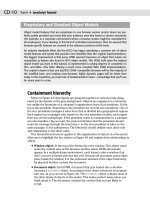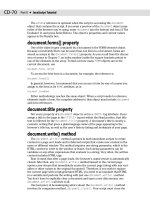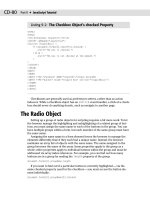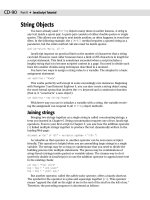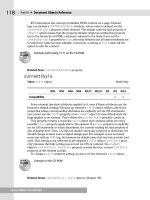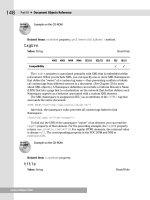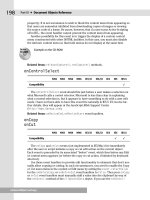JavaScript Bible, Gold Edition part 16 doc
Bạn đang xem bản rút gọn của tài liệu. Xem và tải ngay bản đầy đủ của tài liệu tại đây (159.05 KB, 10 trang )
CD-80
Part II ✦ JavaScript Tutorial
Listing 9-2: The Checkbox Object’s checked Property
<HTML>
<HEAD>
<TITLE>Checkbox Inspector</TITLE>
<SCRIPT LANGUAGE=”JavaScript”>
function inspectBox() {
if (document.forms[0].checkThis.checked) {
alert(“The box is checked.”)
} else {
alert(“The box is not checked at the moment.”)
}
}
</SCRIPT>
</HEAD>
<BODY>
<FORM>
<INPUT TYPE=”checkbox” NAME=”checkThis”>Check here<BR>
<INPUT TYPE=”button” VALUE=”Inspect Box” onClick=”inspectBox()”>
</FORM>
</BODY>
</HTML>
Checkboxes are generally used as preferences setters, rather than as action
inducers. While a checkbox object has an
onClick event handler, a click of a check-
box should never do anything drastic, such as navigate to another page.
The Radio Object
Setting up a group of radio objects for scripting requires a bit more work. To let
the browser manage the highlighting and unhighlighting of a related group of but-
tons, you must assign the same name to each of the buttons in the group. You can
have multiple groups within a form, but each member of the same group must have
the same name.
Assigning the same name to a form element forces the browser to manage the
elements differently than if they each had a unique name. Instead, the browser
maintains an array list of objects with the same name. The name assigned to the
group becomes the name of the array. Some properties apply to the group as a
whole; other properties apply to individual buttons within the group and must be
addressed via array index references. For example, you can find out how many
buttons are in a group by reading the
length property of the group:
document.forms[0].groupName.length
If you want to find out if a particular button is currently highlighted — via the
same checked property used for the checkbox — you must access the button ele-
ment individually:
document.forms[0].groupName[0].checked
CD-81
Chapter 9 ✦ Forms and Form Elements
Listing 9-3 demonstrates several aspects of the radio button object, including
how to look through a group of buttons to find out which one is checked and how
to use the
VALUE attribute and corresponding property for meaningful work.
The page includes three radio buttons and a plain button. Each radio button’s
VALUE attribute contains the full name of one of the Three Stooges. When the user
clicks the button, the
onClick event handler invokes the fullName() function. In
that function, the first statement creates a shortcut reference to the form. Next, a
for repeat loop looks through all of the buttons in the stooges radio button group.
An
if construction looks at the checked property of each button. When a button is
highlighted, the
break statement bails out of the for loop, leaving the value of the
i loop counter at the number where the loop broke ranks. The alert dialog box then
uses a reference to the value property of the
ith button so that the full name can be
displayed in the alert.
Listing 9-3: Scripting a Group of Radio Objects
<HTML>
<HEAD>
<TITLE>Extracting Highlighted Radio Button</TITLE>
<SCRIPT LANGUAGE=”JavaScript”>
function fullName() {
var form = document.forms[0]
for (var i = 0; i < form.stooges.length; i++) {
if (form.stooges[i].checked) {
break
}
}
alert(“You chose “ + form.stooges[i].value + “.”)
}
</SCRIPT>
</HEAD>
<BODY>
<FORM>
<B>Select your favorite Stooge:</B>
<INPUT TYPE=”radio” NAME=”stooges” VALUE=”Moe Howard” CHECKED>Moe
<INPUT TYPE=”radio” NAME=”stooges” VALUE=”Larry Fine” >Larry
<INPUT TYPE=”radio” NAME=”stooges” VALUE=”Curly Howard” >Curly<BR>
<INPUT TYPE=”button” NAME=”Viewer” VALUE=”View Full Name ”
onClick=”fullName()”>
</FORM>
</BODY>
</HTML>
As you learn about form elements in later chapters of this book, the browser’s
tendency to create arrays out of identically named objects of the same type (except
for Internet Explorer 3) can be a benefit to scripts that work with, say, columns of
fields in an HTML order form.
CD-82
Part II ✦ JavaScript Tutorial
The SELECT Object
The most complex form element to script is the SELECT element object. As you
can see from the lowest common denominator object hierarchy diagram (Figures
4-6 or 8-1), the SELECT object is really a compound object: an object that contains
an array of OPTION objects. Moreover, you can establish this object in HTML to
display itself as either a pop-up list or a scrolling list — the latter configurable to
accept multiple selections by users. For the sake of simplicity at this stage, this
lesson focuses on deployment as a pop-up list that allows only single selections.
Some properties belong to the entire SELECT object; others belong to individual
options inside the SELECT object. If your goal is to determine which item the user
selects, you must use properties of both the SELECT and OPTION objects.
The most important property of the SELECT object itself is the
selectedIndex
property, accessed as follows:
document.form[0].selectName.selectedIndex
This value is the index number of the currently selected item. As with most index
counting schemes in JavaScript, the first item (the one at the top of the list) has an
index of zero. The
selectedIndex value is critical for enabling you to access prop-
erties of the selected option. Two important properties of an option item are
text
and value, accessed as follows:
document.forms[0].selectName.options[n].text
document.forms[0].selectName.options[n].value
The text property is the string that appears onscreen in the SELECT object. It is
unusual for this information to be exposed as a FORM object property because in
the HTML that generates a SELECT object, the text is defined outside of the
<OPTION> tag. But inside the <OPTION> tag, you can set a VALUE attribute, which,
like the radio buttons shown earlier, enables you to associate some hidden string
information with each visible entry in the list.
To read the
value or text property of a selected option most efficiently, you can
use the SELECT object’s
selectedIndex property as an index value to the option.
References for this kind of operation get pretty long, so take the time to understand
what’s happening here. In the following function, the first statement creates a short-
cut reference to the SELECT object. The
selectedIndex property of the SELECT
object is then substituted for the
index value of the options array of that same
object:
function inspect() {
var list = document.forms[0].choices
var chosenItemText = list.options[list.selectedIndex].text
}
To bring a SELECT object to life, use the onChange event handler. As soon as a
user makes a new selection in the list, this event handler runs the script associated
with that event handler (except for Windows versions of Navigator 2, whose
onChange event handler doesn’t work for SELECT objects). Listing 9-4 shows a com-
mon application for a SELECT object. Its text entries describe places to go in and
out of a Web site, while the
VALUE attributes hold the URLs for those locations.
CD-83
Chapter 9 ✦ Forms and Form Elements
When a user makes a selection in the list, the onChange event handler triggers a
script that extracts the
value property of the selected option and assigns that
value to the
location object to effect the navigation. Under JavaScript control, this
kind of navigation doesn’t need a separate Go button on the page.
Listing 9-4: Navigating with a SELECT Object
<HTML>
<HEAD>
<TITLE>Select Navigation</TITLE>
<SCRIPT LANGUAGE=”JavaScript”>
function goThere() {
var list = document.forms[0].urlList
location = list.options[list.selectedIndex].value
}
</SCRIPT>
</HEAD>
<BODY>
<FORM>
Choose a place to go:
<SELECT NAME=”urlList” onChange=”goThere()”>
<OPTION SELECTED VALUE=”index.html”>Home Page
<OPTION VALUE=”store.html”>Shop Our Store
<OPTION VALUE=”policies.html”>Shipping Policies
<OPTION VALUE=””>Search the Web
</SELECT>
</FORM>
</BODY>
</HTML>
Internet Explorer and NN6 expose the value property of the selected option item
as the value property of the SELECT object. While this is certainly a logical and
convenient shortcut, for compatibility reasons you should use the long way shown
in Listing 9-4.
There is much more to the SELECT object, including the ability to change the
contents of a list in newer browsers. Chapter 26 covers the object in depth.
Passing Form Data and Elements to Functions
In all of the examples so far in this lesson, when an event handler invokes a func-
tion that works with form elements, the form or form element is explicitly refer-
enced in the function. But valuable shortcuts do exist for transferring information
about the form or form control directly to the function without dealing with those
typically long references that start with the
window or document object level.
JavaScript features a keyword —
this — that always refers to whatever object
contains the script in which the keyword is used. Thus, in an
onChange event
Note
CD-84
Part II ✦ JavaScript Tutorial
handler for a text field, you can pass a reference to the text object to the function
by inserting the
this keyword as a parameter to the function:
<INPUT TYPE=”text” NAME=”entry” onChange=”upperMe(this)”>
At the receiving end, the function defines a parameter variable that turns that
reference into a variable that the rest of the function can use:
function upperMe(field) {
statement[s]
}
The name you assign to the function’s parameter variable is purely arbitrary, but
it is helpful to give it a name that expresses what the reference is. Importantly, this
reference is a “live” connection back to the object. Therefore, statements in the
script can get and set property values of the object at will.
For other functions, you may wish to receive a reference to the entire form,
rather than just the object calling the function. This is certainly true if the function
needs to access other elements of the same form. To pass the entire form, you
reference the
form property of the INPUT object, still using the this keyword:
<INPUT TYPE=”button” VALUE=”Click Here” onClick=”inspect(this.form)”>
The function definition should then have a parameter variable ready to be
assigned to the form object reference. Again, you decide the name of the variable. I
tend to use the variable name
form as a way to remind me exactly what kind of
object is referenced.
function inspect(form) {
statement[s]
}
Listing 9-5 demonstrates passing both an individual form element and the entire
form in the performance of two separate acts. This page makes believe it is con-
nected to a database of Beatles songs. When you click the Process Data button, it
passes the
form object, which the processData() function uses to access the
group of radio buttons inside a
for loop. Additional references using the passed
form object extract the value properties of the selected radio button and the text
field.
The text field has its own event handler, which passes just the text field to the
verifySong() function. Notice how short the reference is to reach the value
property of the song field inside the function.
Listing 9-5: Passing a Form Object and Form
Element to Functions
<HTML>
<HEAD>
<TITLE>Beatle Picker</TITLE>
<SCRIPT LANGUAGE=”JavaScript”>
function processData(form) {
for (var i = 0; i < form.Beatles.length; i++) {
if (form.Beatles[i].checked) {
break
}
}
CD-85
Chapter 9 ✦ Forms and Form Elements
// assign values to variables for convenience
var beatle = form.Beatles[i].value
var song = form.song.value
alert(“Checking whether “ + song + “ features “ + beatle + “ ”)
}
function verifySong(entry) {
var song = entry.value
alert(“Checking whether “ + song + “ is a Beatles tune ”)
}
</SCRIPT>
</HEAD>
<BODY>
<FORM onSubmit=”return false”>
Choose your favorite Beatle:
<INPUT TYPE=”radio” NAME=”Beatles” VALUE=”John Lennon” CHECKED>John
<INPUT TYPE=”radio” NAME=”Beatles” VALUE=”Paul McCartney”>Paul
<INPUT TYPE=”radio” NAME=”Beatles” VALUE=”George Harrison”>George
<INPUT TYPE=”radio” NAME=”Beatles” VALUE=”Ringo Starr”>Ringo<P>
Enter the name of your favorite Beatles song:<BR>
<INPUT TYPE=”text” NAME=”song” VALUE = “Eleanor Rigby”
onChange=”verifySong(this)”><P>
<INPUT TYPE=”button” NAME=”process” VALUE=”Process Request ”
onClick=”processData(this.form)”>
</FORM>
</BODY>
</HTML>
Get to know the usage of the this keyword in passing form and form element
objects to functions. The technique not only saves you typing in your code, but it
also ensures accuracy in references to those objects.
Submitting and Prevalidating Forms
If you have worked with Web pages and forms before, you are familiar with how
simple it is to add a Submit-style button that sends the form to your server.
However, design goals for your page may rule out the use of ugly system-generated
buttons. If you’d rather display a pretty image, the link tag surrounding that image
should use the
javascript: URL technique to invoke a script that submits the
form (the image type of
INPUT element is not recognized prior to IE4 and NN6).
The scripted equivalent of submitting a form is the FORM object’s
submit()
method. All you need in the statement is a reference to the form and this method:
document.forms[0].submit()
One limitation might inhibit your plans to secretly have a script send you an
e-mail message from every visitor who comes to your Web site. If the form’s
ACTION
attribute is set to a mailTo: URL, JavaScript does not pass along the submit()
method to the form. See Chapter 23 for cautions about using the mailTo: URL as a
form’s action.
CD-86
Part II ✦ JavaScript Tutorial
Before a form is submitted, you may wish to perform some last-second validation
of data in the form or in other scripting (for example, changing the form’s
action
property based on user choices). You can do this in a function invoked by the
form’s
onSubmit event handler. Specific validation routines are beyond the scope
of this tutorial (but are explained in substantial detail in Chapter 43), but I want to
show you how the
onSubmit event handler works.
In all but the first generation of scriptable browsers from Microsoft (IE3) and
Netscape (NN2), you can let the results of a validation function cancel a submission
if the validation shows some incorrect data or empty fields. To control submission,
the
onSubmit event handler must evaluate to return true (to allow submission to
continue) or
returnfalse (to cancel submission). This is a bit tricky at first
because it involves more than just having the function called by the event handler
return
true or false. The return keyword must be part of the final evaluation.
Listing 9-6 shows a page with a simple validation routine that ensures all fields
have something in them before allowing submission to continue. (The form has no
ACTION attribute, so this sample form doesn’t get sent to the server.) Notice how
the
onSubmit event handler (which passes a reference to the FORM object as a
parameter — in this case the
this keyword points to the FORM object because its
tag holds the event handler) includes the
return keyword before the function
name. When the function returns its
true or false value, the event handler
evaluates to the requisite
return true or return false.
Listing 9-6: Last-Minute Checking Before Form Submission
<HTML>
<HEAD>
<TITLE>Validator</TITLE>
<SCRIPT LANGUAGE=”JavaScript”>
function checkForm(form) {
for (var i = 0; i < form.elements.length; i++) {
if (form.elements[i].value == “”) {
alert(“Fill out ALL fields.”)
return false
}
}
return true
}
</SCRIPT>
</HEAD>
<BODY>
<FORM onSubmit=”return checkForm(this)”>
Please enter all requested information:<BR>
First Name:<INPUT TYPE=”text” NAME=”firstName”><BR>
Last Name:<INPUT TYPE=”text” NAME=”lastName”><BR>
Rank:<INPUT TYPE=”text” NAME=”rank”><BR>
Serial Number:<INPUT TYPE=”text” NAME=”serialNumber”><BR>
<INPUT TYPE=”submit”>
</FORM>
</BODY>
</HTML>
CD-87
Chapter 9 ✦ Forms and Form Elements
One quirky bit of behavior involving the submit() method and onSubmit event
handler needs explanation. While you might think (and logically so, in my opinion)
that the
submit() method would be the exact scripted equivalent of a click of a
real Submit button, it’s not. In Navigator, the
submit() method does not cause the
form’s
onSubmit event handler to fire at all. If you want to perform validation on a
form submitted via the
submit() method, invoke the validation in the script func-
tion that ultimately calls the
submit() method.
So much for the basics of forms and form elements. In the next chapter, you step
away from HTML for a moment to look at more advanced JavaScript core language
items: strings, math, and dates.
Exercises
1. Rework Listings 9-1, 9-2, 9-3, and 9-4 so that the script functions all receive the
most efficient form or form element references from the invoking event
handler.
2. Modify Listing 9-6 so that instead of the Submit button making the submis-
sion, the submission is performed from a hyperlink. Be sure to include the
form validation in the process.
3. In the following HTML tag, what kind of information do you think is being
passed with the event handler? Write a function that displays in an alert
dialog box the information being passed.
<INPUT TYPE=”text”NAME=”phone” onChange=”format(this.value)”>
4. A document contains two forms named specifications and accessories.
In the
accessories form is a field named acc1. Write two different state-
ments that set the contents of that field to
Leather Carrying Case.
5. Create a page that includes a SELECT object to change the background color
of the current page. The property that you need to set is
document.bgColor,
and the three values you should offer as options are
red, yellow, and green.
In the SELECT object, the colors should display as
Stop, Caution, and Go.
Note: If you use a Macintosh or UNIX version of Navigator, you must employ
version 4 or later for this exercise.
✦✦✦
and Dates
F
or most of the lessons in the tutorial so far, the objects at
the center of attention belong to the document object
model. But as indicated in Chapter 2, a clear dividing line
exists between the document object model and the JavaScript
language. The language has some of its own objects that are
independent of the document object model. These objects are
defined such that if a vendor wished to implement JavaScript
as the programming language for an entirely different kind of
product, the language would still use these core facilities for
handling text, advanced math (beyond simple arithmetic),
and dates. You can find formal specifications of these objects
in the ECMA-262 recommendation.
Core Language Objects
It is often difficult for newcomers to programming — or
even experienced programmers who have not worked in
object-oriented worlds before — to think about objects,
especially when attributed to “things” that don’t seem to have
a physical presence. For example, it doesn’t require lengthy
study to grasp the notion that a button on a page is an object.
It has several physical properties that make perfect sense. But
what about a string of characters? As you learn in this chap-
ter, in an object-based environment such as JavaScript, every-
thing that moves is treated as an object — each piece of data
from a Boolean value to a date. Each such object probably has
one or more properties that help define the content; such an
object may also have methods associated with it to define
what the object can do or what you can do to the object.
I call all objects that are not part of the document object
model core language objects. You can see the full complement
of them in the Quick Reference in Appendix A. In this chapter,
I focus on the
String, Math, and Date objects.
10
10
CHAPTER
✦✦✦✦
In This Chapter
How to modify strings
with common string
methods
When and how to
use the
Math object
How to use the
Date
object
✦✦✦✦


